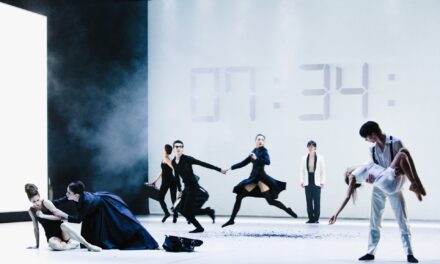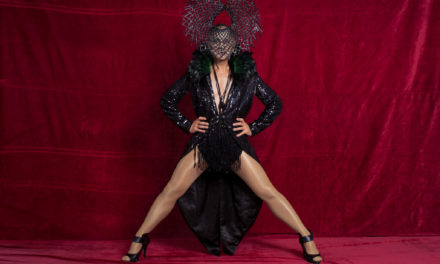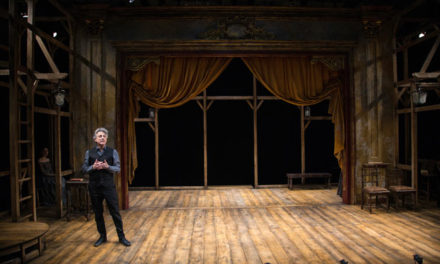Kirsty Sedgman‘s background is in performance studies, which, according to her, tends to make big assumptions about audiences: who they are, why they attend, and what they get out of theatre. After encountering the rich field of audience studies, she became committed to research that talks to rather than talks about audiences.
How did you find your way from Creative Writing to Audience Development? What is the biggest challenge for you in it?
My background initially was in theatre studies – I did the undergraduate BA at Birmingham University. It was a great course, and I got a lot from it: particularly those modules that made us think carefully about audience experience. However, here our approach to audiences was chiefly speculative. Indeed, this is still true for many people studying theatre, I think. Within performance studies, for the most part, we still tend to talk about the audience as if we know what they’re thinking and feeling when they walk out of the theatre – or perhaps what they should think and feel, based on our own readings of the event. This approach carried forwards into my Masters degree in Creative Writing at Warwick, where I read yet more books explaining how we could affect readers through writing, and what different techniques can do with, for, and to people. But of course, there’s not really any such thing as ‘the audience’ at all. We all know that audiences are made up of various individuals and that their experiences will necessarily differ – but historically there has been real resistance within performance studies to drawing out these different experiences in any real sense. In fact, I’ve collected quite a list of all the methodological, ethical, and epistemological reasons people have given me for why empirical audience research is problematic in relation to theatre. So when I first proposed my PhD (to a different university), initially planning to investigate the role of audiences in contemporary performances, I was advised to steer well clear of the messiness involved in trying to capture real discursive information. I was relieved! Honestly, that sounded hard. But this fell through and then suddenly we were relocating to Wales, and at the same time I became aware of this amazing audience research journal – Participations – whose founder Prof. Martin Barker was based in Aberystwyth. I asked to meet him and pitched my PhD, and over coffee he asked me a question. “Do you plan to talk to audiences?”. I said no, which had previously been the right answer – but this time he asked me another question. “Why not?”. And I didn’t have a good answer then, and I still don’t today. That was back in 2009, so seven years later here I am: thanks to Martin Barker, one of the best-trained researchers in empirical theatre audience research, and poised on the cusp of an emerging field. But while my research is tangentially related to audience development, because the data I produce can absolutely be used to better understand and target audiences, I should explain that this kind of interventionist approach isn’t really my personal focus. Rather, my work aims to map the complex ways that different audience members, drawing on diverse subject positions, find meaning and value in their arts encounters.
If I understood correctly you were involved in framing/developing the National Theatre of Wales new audience outreach/development program. How was the process? Can you tell me please how do you see it now? What is the outcome of it? Is it measurable? Also, can we know a little bit about the outcome of your book: Locating the Audience: How People Found Value in National Theatre Wales?
Actually, my PhD research was undertaken entirely independently, made possible by a scholarship from the Department of Theatre, Film & TV Studies at Aberystwyth University. Though the project had the support of National Theatre Wales, who at that time were in the process of launching, it wasn’t supported by them. They had no financial stake in my research, and although they allowed me access this was only on the condition that I helped out with their launch year productions and ‘didn’t get in the way’ (as the company’s founding Artistic Director John E. McGrath says himself, in the foreword to my book!). And actually, I found this degree of independence to be a very good thing. When performing empirical audience research it’s useful to be able to assert your lack of personal stake in the arts activity, and to stress that candid answers honestly are welcomed. While most of the audiences to whom I spoke were very complimentary about the company’s work, there were some hesitations about how NTW had engaged communities and performed locations in their ambitious inaugural year. Taking a step back from the company allowed me to explore these conflicting responses with more confidence. Having said this, though, my findings did feed into National Theatre Wales’ future planning – though it’s impossible to ‘measure’ the outcomes of this in any meaningful way. That’s one of the things my work seeks to address, actually: the urgent need to widen our understanding of terms like ‘impact’ and ‘value’. In Locating the Audience: How People Found Value in National Theatre Wales (2016, Intellect) I argue that rather than seeing an impact as an end point, something fixed and finite, we should instead pay attention to the processes by which different people find meaning in cultural events. By analyzing not only what people say but how they say it, as people search for words to explain their experiences, I hoped to shed new light on how this process works in action.
You also had a cooperation with the German-based performance group Rimini Protokoll, that will be published soon. Can you maybe tell more about it? How did you cooperate?
I hope it will be published soon! I’m currently completing a new article which I’m about to submit – so wish me luck. This article explores the third ‘bonus’ case-study that didn’t make it into my book: Rimini Protokoll’s 2010 collaboration with National Theatre Wales. Outdoors was a walking tour of Aberystwyth led by local guides. A maximum 13 audience members turned up on a Tuesday evening (the performance took place every week for a year) and were handed an iPod each. Putting on their headphones, audiences watched the iPod screens on which, weeks earlier, a member of the local choir Heartsong had recorded a video of Aberystwyth as they walked around town. The job of participants was to follow their guide around town as they wound through streets and alleyways. What interested me about this performance was the dual perception of Aberystwyth, experienced simultaneously as a past onscreen and as a present on the street: cars present onscreen but absent in reality; joggers on the seafront both there and not… My role in this performance was to test out the format beforehand. Alongside a number of other volunteers I was given one of the brand new iPods and asked to walk around town by myself, recording my journey as I went, taking my future viewer to places with personal relevance and chatting to them throughout. I was then paired with a choir member and asked to encourage them to tell me their stories of Aberystwyth as we walked. The payoff for all this, of course, was the ability to capture responses from audience members afterward. What I found fascinating from this research, and what I explore in the article, were the tactics people used to manage their perception: between feelings of intimacy with the ‘real experts’ who were guiding them around town with the competing knowledge that this was not a face-to-face encounter but a digital simulacra, as well as between the ‘layers’ of place that were presented: as narrative past, videoed past, and real-time present juxtaposed.
Is it possible to develop audience engagement strategy without personal contact but only via online outreach?
Another strand of my research asks how people access and respond to live performances in mediated ways. For example, how might watching a YouTube video of a once-live performance still in some ways be experienced as a live event – and where does it fall short? In doing so I’m working to dismantle unhelpful binary distinctions between ‘activity’ and ‘passivity’, ‘good’ and ‘bad’ art forms, and ‘personal’ and ‘online’ domains: boundaries which for many people are increasingly blurred. This isn’t to say that I don’t recognize ontological differences between live events and recorded – of course, these are not the same. But I do see a real need to shift our perspective on value judgments like ‘intimacy’, ‘distance’, ‘liveness’, ‘presence’, and so on. Rather than considering these things to be the natural outcomes of production processes, we need instead to pay closer attention to how these are understood in and through processes of reception. For example, I’ve got an article coming out in the next issue of Studies in Musical Theatre (10:1, 2016) where I ask the following question: if a spectacular musical number, accessed as a recorded video months after its live performance, is experienced in some ways as an intimate encounter, who are we to dismiss the validity of that response? The challenge facing all arts organizations is how to embrace different kinds of values and processes, rather than imposing their own versions.
How do you see the future of audience development? How do you see what could be the techniques/practicalities that could be introduced into this process?
Following on from my last answer, I’ve spoken to a number of cultural industry people recently who are worrying about how to encourage audiences from diverse backgrounds to feel senses of belonging and ownership over their work. They want to know how to address cultural resistance: to counter the worry, experienced by many people, that this kind of thing simply isn’t for them. The online world is not by any means untethered from ongoing exclusions and power relations. But it does offer new potentials for opening up the cultural conversation to new audiences, encouraging different people to participate in ways that are meaningful for them and to take part in fluid and evolving communities. Instead of ‘outreach’ programmes, which often seek to draw people in to the kinds of participation that we think are valuable, we should instead be asking: who is already out there? What are they already doing? What kinds of conversations are happening right now? What are the points of intersection? And how can we tap into all that rich, diverse, ongoing activity – in both live and digital ways?
What are the biggest failures nowadays when we want to combine digital technologies and audience development? And can you please also tell good examples/best practices?
I think a common failure is to assume that using digital technologies within the arts will be ipso facto emancipatory, allowing arts-makers instantly to connect with a brand new kind of audience. While it’s certainly the case that drawing live performance into the online world opens up new possibilities for diverse audiences to access theatrical events, there’s a real tendency to assume that just because people can access these things they necessarily will. I’m thinking particularly of the rise of theatre companies who are digitally streaming their performances and encouraging people to live-tweet along. I’ve seen some fantastic examples of this lately, where the digital element was absolutely built into the show – but still, the people tweeting seemed almost entirely to be writing from what you might call an ‘expert’ subject position. By and large, these were not first-time audiences. So cultural institutions should think about working towards a multi–layered approach, accepting that different digital platforms are bound to attract different kinds of engagement. For example, I’ve always admired National Theatre Wales’ online community: it’s kind of like a new social platform for people interested in the arts in Wales. But as John McGrath himself acknowledged, the people active on their site tended to be those with professional involvement in the Welsh arts scene already. So it was important for NTW to develop a number of different routes to engagement, some online and some offline, in order to draw in a richer spread of audiences. This is obviously a really tricky thing to pull off. Indeed, what my own research (along with that of many others) has found is the extent to which many people feel cut off from arts experiences, as if they’re totally alien and divorced from their own lives. As I say in the book, increasing access means more than just opening the doors a little wider. There’s frequently a real resistance, for many people, to crossing that threshold at all. In audience development terms this tends to be discussed in terms of removing ‘barriers to access’. Taking advantage of the affordances offered by the digital domain might remove physical/economic/geographical barriers, but those conceptual barriers are often still all too firmly in place. This is not a new concept, of course – other people within my field who have talked persuasively about these ideas include Lynne Conner, Matthew Reason, Katya Johanson & Hilary Glow… But in terms of working towards models of best practice, I still think the key is to figure out how to tap into all those things people already do/care about. Stop trying to impose the culture we think is important on communities; stop using outreach programmes to draw people in with ‘soft’ arts activities in order to try to hook them on the ‘hard’ stuff; stop assuming that communities and audiences are wholeheartedly embracing your work just because you think it’s accessible. Instead, find new ways to draw out and map the complexity of diverse people’s engagements with your work. And start thinking of digital technologies as an integral part of everything you do: bring it into the heart of the artwork, rather than adding digital stuff on afterward. Audiences can sniff out tokenism, I think. So I suppose at its broadest my conceptual model of best practice works to draw diverse audiences into genuine conversations: taking seriously the things that different people want, feel, do, and say, rather than listening only to the bits we want to hear.
Is it possible to introduce game/gamification tools in audience development process? If yes can you tell maybe some examples?
Gamification can be a great way to meet people on their own turf, by engaging people in activities that are already a meaningful part of their lives. And for me, theatre is all about encouraging audiences to develop ludic relationships with the world. If we begin to see ourselves as sociopolitical performers (even if this performance mostly takes place only on the micro-scale of our daily lives) then theatre can offer a protected space to try out new kinds of performances. That’s also what games can do. For example, I recently had a taster of Coney’s new performance Codename: REMOTE, which they’re marketing as ‘a playful parable about freedom of choice and the internet’. It was a bit like a choose-your-own-adventure game, with audience members presented with a series of choices that influenced the outcome of the narrative. We either had to dream of a better world and collectively work towards it – or break into factions guided by self-interest and a desire for power. And populist things like Zombie Run are brilliant at that, too – allowing us to test out new ways of being, to see the consequences of our decisions and actions unfolding before us. The problem is that we often tend to separate this kind of live immersive experience from ‘proper’ theatre; while actually, I think we should be embracing games as theatre rather than seeking to hierarchize, to legitimize. And games can be an especially great way of getting people to engage in cultural institutions – to break people away from the restrictive, off-putting models of behavior we still think are expected. I dream of the day when theatres begin to stage, say, a performative scavenger hunt around a city, which culminates in hundreds of people converging at the building taking joyful ownership over its spaces; or when I’m allowed to play hide-and-seek in an art gallery with my son without getting tutted at. Most people these days don’t want to encounter creative activities in reverent silence. I mean, I certainly don’t! I want to engage loudly, debate fiercely, experience communally. That doesn’t necessarily mean you have to do a Punchdrunk, encouraging people to roam around large spaces and seek out spectacle (in fact, I’ve lined up an article in Contemporary Theatre Review that shows how this kind of experience can in its own way be exclusionary). But thinking playfully can be a useful way to help people shed the weight of that sense that there’s a ‘right’ and a ‘wrong’ way to experience art.
This article was originally published on Zip-Scene.com. Reposted with permission. Read the original article.
This post was written by the author in their personal capacity.The opinions expressed in this article are the author’s own and do not reflect the view of The Theatre Times, their staff or collaborators.
This post was written by Ágnes Bakk.
The views expressed here belong to the author and do not necessarily reflect our views and opinions.


















